
Transformation in bacteria
- 1. DR. VIBHA KHANNA ASSO. PROF. (BOTANY) S.P.C. GOVERNMENT COLLEGE AJMER (RAJASTHAN)
- 2. CYTOGENETICS • BLOCK 2: HORIZONTAL GENE TRANSFER IN BACTERIA • PRESENTATION 2: GENETIC TRANSFORMATION IN BACTERIA;
- 3. What is Bacterial Transformation? • Transformation is the direct uptake, incorporation and expression of exogenous genetic material from its surroundings. • Bacterial transformation is a process of horizontal gene transfer by which some bacteria take up foreign genetic material (naked DNA) from the environment. • It was first reported in Streptococcus pneumoniae by Griffith in 1928. • DNA as the transforming principle was demonstrated by Avery et al in 1944.
- 4. Griffith Experiment and Its Results • In the 1920s, while studying two different strains of a bacterium, called R (rough) strain and S (smooth) strain, Frederick Griffith made an important discovery. • Method: – He injected the two strains into mice. – The S strain killed (virulent) the mice, but the R strain did not (non- virulent). – Griffith also injected mice with heat killed S-strain bacteria. As expected, the killed bacteria did not harm the mice. – However, when the dead S-strain bacteria were mixed with live R- strain bacteria and injected, the mice died. • Inference: – Based on his observations, Griffith deduced that something in the killed S strain was transferred to the previously harmless R strain, making the R strain deadly. – He called this process transformation, as something was "transforming" the bacteria from one strain into another strain.
- 5. Griffith Experiment and Its Results
- 6. Avery, Macleod and McCarty Experiment to identify the ‘Transforming Principle’
- 7. Bacterial Gene Transformation • Transformation is a form of genetic recombination in which a DNA fragment from a dead, degraded bacterium enters a competent recipient bacterium and is exchanged for a piece of DNA of the recipient. • Transformation usually involves only homologous recombination, a recombination of homologous DNA regions having nearly the same nucleotide sequences. • Typically this involves similar bacterial strains or strains of the same bacterial species.
- 8. Bacterial Gene Transformation • Once the transforming factor (DNA) enters the cytoplasm, it may be degraded by nucleases if it is different from the bacterial DNA. • If the exogenous genetic material is similar to bacterial DNA, it may integrate into the chromosome. • Sometimes the exogenous genetic material may co-exist as a plasmid with chromosomal DNA.
- 9. Bacterial Gene Transformation • The prerequisite for bacteria to undergo transformation is its ability to take up free, extracellular genetic material. Such bacteria are termed as ‘competent cells’. • The process of gene transfer by transformation does not require a living donor cell but only requires the presence of persistent DNA in the environment. • The factors that regulate natural competence vary between various genera.
- 10. Transformation: Step 1: A donor bacterium dies and is degraded Step 2: DNA fragments, from the dead donor bacterium bind to transformasomes on the cell wall of a competent, living recipient bacterium.
- 11. Transformation: Step 3: Then, a nuclease degrades one strand of the donor fragment and the remaining DNA strand enters the recipient. Competence-specific single-stranded DNA-binding proteins bind to the donor DNA strand to prevent it from being degraded in the cytoplasm. Step 4: RecA proteins promotes genetic exchange between a fragment of the donor's DNA and the recipient's DNA This involves breakage and reunion of paired DNA segments.
- 12. Significance of Transformation • The phenomenon of natural transformation enable the bacterial populations to overcome great fluctuations in population dynamics and overcome the challenge of maintaining the population numbers during harsh and extreme environmental changes. • This is achieved when some bacterial genera spontaneously release DNA from the cells into the environment, free to be taken up by the competent cells. The competent cells also respond to the changes in the environment and control the level of gene acquisition through natural transformation process.
- 13. Applications of Transformation • The phenomenon of transformation has been widely used in molecular biology. As they are easily grown in large numbers, transformed bacteria may be used as host cells for the following: – to make multiple copies of the DNA – in cloning procedures – to express large amounts of proteins and enzymes – in the generation of cDNA libraries – in DNA linkage studies
- 14. Biology of Homologous Recombination in Bacteria ???? • This will be dealt with in ‘Presentation 3’ of ‘Block 2’.